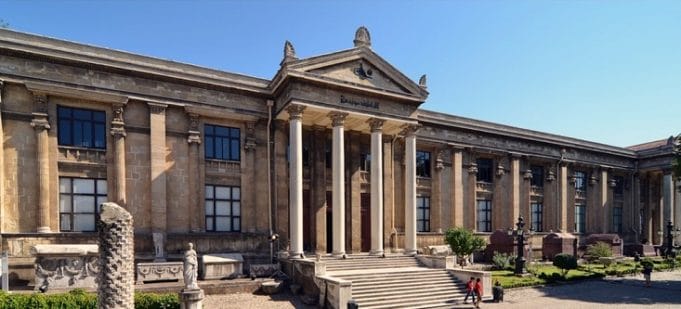The Istanbul Archaeology Museum is housed in three buildings just inside the first court of Topkapi Palace and includes theMuseum of the Ancient Orient. The museum has an excellent collection of Greek and Roman artifacts, including finds from Ephesus and Troy.
Collections of the Istanbul Archaeology Museum
The Istanbul Archaeological Museum houses over one million objects, the most extraordinary of which are the sarcophagi that date back as far as the 4th century BC. The museum excels, however, in its rich chronological collection of locally found artifacts that shed light on the origins and history of the city.
Near the entrance is a statue of a lion representing the only piece saved from the clutches of British archaeologists from theMausoleum of Halicarnassus, one of the Seven Wonders of the Ancient World.
On the upper floor of the building there are small stone works, pots and pans, small terracotta statues, 800,000 Ottoman coins, seals, decorations, and medals, and a library with 70,000 books.

In the halls to the left is a collection of sarcophagi found at Sidon (ancient Syria) representing various architectural styles influenced by outside cultures including Egypt, Phoenicia, and Lycia. The most famous is the Alexander Sarcophagus, covered with astonishingly advanced carvings of battles and the life of Alexander the Great, discovered in 1887 and once believed to have been that of the emperor himself (it was actually Sidonian King Abdalonymos).
Found in the same necropolis at Sidon is the stunningly preserved Sarcophagus of the Crying Women, with 18 intricately carved panels showing figures of women in extreme states of mourning.
On the mezzanine level is the exhibit “Istanbul Through the Ages,” a rich and well-presented exhibit that won the museum the Council of Europe Museum Award in 1993. To put the exhibit into perspective, the curators have provided maps, plans, and drawings to illustrate the archaeological findings, displayed thematically, which range from prehistoric artifacts found west of Istanbul to 15th-century Byzantine works of art.
The recovered snake’s head from the Serpentine Column in the Hippodrome is on display, as is the 14th-century bell from the Galata Tower. The upper two levels house the Troy exhibit and displays on the evolution of Anatolia over the centuries, as well as sculptures from Cyprus, Syria, and Palestine.
The newly renovated and reopened Museum of the Ancient Orient is an exceptionally rich collection of artifacts from the earliest civilizations of Anatolia, Mesopotamia, Egypt, and the Arab continent. The tour begins with pre-Islamic divinities and idols taken from the courtyard of the Al-Ula temple, along with artifacts showing ancient Aramaic inscriptions and a small collection of Egyptian antiquities.
Uncovered in the region of Mesopotamia and on display is an obelisk of Adad-Nirari IIIinscribed with cuneiform characters. Of particular significance is a series of colored mosaic panels showing animal reliefs of bulls and dragons with serpents’ heads from the monumental Gate of Ishtar, built by Nebuchadnezzar, King of Babylonia.
A pictorial representation on a Sumerian devotional basin of girls carrying pitchers of water whose contents are filling an underground source relates to the ancient Mesopotamian belief that the world was surrounded by water, a belief that has provoked questions over the origins of the biblical Great Flood.
With nothing dating more recent than the 1st century AD, pretty much everything here has enormous significance. But two of the highlights are easily the fragments of the 13-century BC sphinx from the Yarkapi Gate at Hattusas and one of the three known tablets of the Treaty of Kadesh, the oldest recorded peace treaty signed between Ramses II and the Hittites in the 13th-century BC inscribed in Akkadian, the international language of the era. (Another tablet is in the Staatliche Museum in Berlin.)
Visitor Information for the Istanbul Archaeology Museum
| Location: | Topkapi Palace (to the right of and behind St. Irene), Gülhane Park, Istanbul, Turkey |
| Phone: | |
| Hours: | Tues-Sun 9am-5pm (but can vary – check ahead of time) |
| Cost: | $3.50; includes the Museum of the Ancient Orient and the Çinili Kösk |
More Information on the Istanbul Archaeology Museum
- Istanbul Archaeology Museum – Turkey Ministry of Culture and Tourism
Hiç yorum yok:
Yorum Gönder